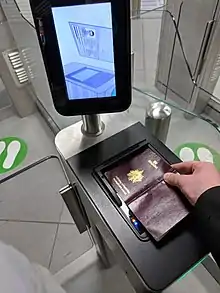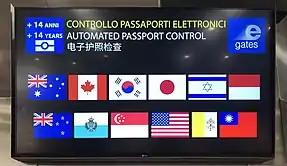EGate (Italy)
ePassport gates are automated self-service barriers operated by the Polizia di Frontiera and located at selected immigration checkpoints in non-Schengen arrival and departure halls in some airports across Italy, offering an alternative to using desks staffed by immigration officers. The gates use facial recognition technology to verify the user's identity against the data stored in the chip in their biometric passport. As of 18 August 2020, due to the Italian Government COVID-19 restrictions, the eGates cannot be used on arrival and all incoming travelers are processed manually.

Eligibility

The system can be used by the following biometric passport holders, aged 14 and over:
|
At Rome Fiumicino, Milan Malpensa, Treviso, Venice Marco Polo, Bologna and Verona airports, eGates are also available to the following non-EU biometric passport holders (aged 14 and over):
1 – only for those holding a passport with National ID number.
However these citizens, after a successful eGate crossing, will still be referred to a border force agent that makes the final entry decision and stamps the passport.
The eGates do not accept national identity cards.
How does it work
To use the eGates, you must have an eligible biometric passport. These biometric passports have the biometric logo on the front cover. The eGate reads all the information contained in the chip inside the passport, and checks that the image captured by camera matches the one on the passport (facial recognition). Passengers’ biometric and personal information (such as photograph and date of birth) are cross-checked against various national, European and international databases.
Availability
There are over 200 eGates in operation at airports throughout Italy.
At present, eGates are available at fifteen international airports:
See also
- ePassport gates the system operated in the United Kingdom
- SmartGate - a similar system operated in Australia and New Zealand
- Parafe - a similar system operated in France
- Biometric passport
- European Automated Border Control systems
References
- "Naples introduces ABC eGates for EU passengers".
- "Aeroporti di Roma - E-gates".
- "Aeroporti di Roma - E-gates".
- "Bologna Airport gets ABC e-Gates".
- "CHECKS AND SECURITY Security rules, regulations and procedures at Venice Marco Polo Airport". veniceairport.it.
- "L'aeroporto attiva gli E-Gate | Sogaer". www.sogaer.it. Retrieved 2019-05-31.
- "EUROPEAN AND SWISS WITH BIOMETRIC PASSPORT E-GATES". trevisoairport.it.